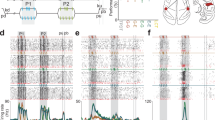Abstract
This paper explores the information coding performed by the local circuit of the Cuneate Nucleus (CN). On the basis of physiological data, we have developed a realistic computational model and studied its output in response to different types of plausible cutaneous stimuli. Computer simulations show that (1) static stimuli are encoded in progressive spatio-temporal patterns made up of single-spike trains generated by each stimulated neuron, and (2) moving stimuli are encoded with a bursting discharge of those units responding to the leading edge of the stimulus. These results suggest that the role of CN could be to transform the stimulus representation in order to facilitate both discrimination and classification in later processing stages.
Similar content being viewed by others
References
Aguilar J, Soto C, Rivadulla C, Canedo A (2002) The lemniscal-cuneate recurrent excitation is suppressed by strychnine and enhanced by GABA A antagonists in the anaesthetized cat. European Journal of Neuroscience 16:1697–1704
Aguilar J, Rivadulla C, Soto C, Canedo A (2003) New corticocuneate cellular mechanisms underlying the modulation of cutaneous ascending transmission in anesthetized cats. Journal of Neurophysiology 89:3328–3339
Berkley KJ, Badell RJ, Blomqvist A, Bull M (1986) Output Systems of the Dorsal Column Nuclei in the cat. Brain Research Reviews 11:199–225
Canedo A, Aguilar J, Mariño J (2000) Lemniscal recurrent and transcortical influences on cuneate neurons. Neuroscience 97(2):317–334
Cheema S, Whitsel BL, Rustioni A (1983) The corticocuneate pathway in the cat: relations among terminal distribution patterns, cytoarchitecture, and single neuron funcional properties. Somatosensory Research 2:169–205
Kuypers HGJM, Tuerk JD (1964) The distribution of the cortical fibers within the nuclei cuneatus and gracilis in the cat. Journal of Anatomy 98:143–162
Lue JH, Luai SM, Wang TJ, Shieh JY, Wen CY (1997) Synaptic relationships between corticocuneate terminals and glycine-immunoreactive neurons in the rat cuneate nucleus. Brain Research 771:167–171
Malinov R, Otmakhov N, Blum KI, Lisman J (1994) Visualizing hippocampal synaptic function by optical detection of Ca2+ entry through the N-methyl-D-aspartate channel. Proceedings of the National Academy of Sciences USA 91:8170–8174
Martinez-Conde S, Macknik SL, Hubel DH (2000) Microsaccadic eye movements and firing of single cells in the striate cortex of macaque monkeys. Nature Neuroscience 3(3):251–258
Navarro J, Canedo A and Sánchez E (2004a) Progressive Coding in the dorsal column nuclei. Proceedings of FENS. Abstr. Vol 2 A.190.12
Navarro J, Sánchez E, Canedo A (2004b) Spatio-temporal information coding in the cuneate nucleus. Proceedings of Brain Inspired Computational Systems (BICS). 2:1–7
Nicolelis M, Fanselow E (2002) Thalamocortical optimization of tactile processing according to behavioral state. Nature Neuroscience 5(6):517–523
Nuñez A, Panetsos F, Avendaño C (2000) Rhythmic neuronal interactions and synchronization in the rat dorsal column nuclei. Neuroscience 100(3):599–609
Sánchez E, Barro S, Canedo A (2415) Edge detection and motion discrimination in the cuneate nucleus. Lecturer Notes in Computer Science 2415:198–203
Sánchez E, Barro S, Mariño J, Canedo A (2003) A computational model of cuneothalalamic projection neurones. Network: Computer Neural System 14:211–231
Sánchez E, Aguilar J, Rivadulla C, Canedo A (2004) The Role of Glycinergic Interneurons in the Dorsal Column Nuclei. Neurocomputing 58–60:1049–1055
Sánchez E, Barro S, Mariño J and Canedo A (2006) Cortical modulation of dorsal column nuclei: a computational study. Journal of Computational Neuroscience 21: 21–33
Shamma S (1998) Spatial and temporal processing in central auditory networks. In: Koch C and Segev I (eds) Methods in Neuronal Modeling, pp. 411–460
Sherman SM (2001) Tonic and burst firing: dual modes of thalamocortical relay. Trends in Neuroscience 24(2):122–126
Thorpe SJ and Gautrais J (1998) Rank order coding: a new coding scheme for rapid processing in neural networks. In: Bower J (ed) Computational Neuroscience: Trends in Research, pp. 113–119
Acknowledgements
We would like to thank to Laboratorios de Neurociencia y Computación neuronal (LANCON), the environment in which this work has been developed, and the support from the Ministry of Science and Technology through grant BFI 2003-01940.
Author information
Authors and Affiliations
Corresponding author
Rights and permissions
About this article
Cite this article
Navarro, J., Sánchez, E. & Canedo, A. Information coding in early stages of the somatosensory system. Nat Comput 6, 253–267 (2007). https://doi.org/10.1007/s11047-006-9012-x
Received:
Accepted:
Published:
Issue Date:
DOI: https://doi.org/10.1007/s11047-006-9012-x




